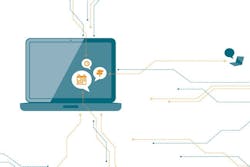Collision shop owners are always looking for ways to improve communication with customers, who these days interact in more ways than ever before.
If you’re looking for something beyond phone calls, emails and text messages, one communication method that is gaining momentum is live chat software, which allows customers to use the Web to instant-message repairer facilities. Shop operators across the nation are getting on board with the technology, and customers are responding positively.
Many shops that have tried live chat say it has boosted customer satisfaction, and there’s little to no risk because it’s inexpensive or even free to use.
“It’s giving our customer another option in communication,” says Jim Byron, who owns Patterson Auto Body, a $3-million-per-year, 7,500-square-foot shop in Patterson, N.Y.
Live chat systems are generally affordable and simple for both shop employees and customers to use.
Laurie Kaiser, marketing manager at LaMettry’s Collision Inc. in Minneapolis and St. Paul, says the company started using live chat software nearly a year ago. Kaiser’s work in marketing and advertising involves webinar training sessions and keeping an eye on trends.
—Laurie Kaiser, marketing manager, LaMetry’s Collision Inc.
She heard about live chat, and consulted the body shop’s online management company, which runs its website. That company found free software for LaMettry’s.
When the company started using it, more customers elected to chat live than LaMettry’s expected. “It even surprised us a little bit,” Kaiser says.
About one person per day uses it, she says. But it doesn’t cost anything, and one person who handles customer calls at the company’s call center also easily manages the live-chat system. It’s easy to justify.
“I think everybody should have it,” she says. “With little to no investment, I just don’t see how you can go wrong.”
She suggests other shops find a free system. Even if your shop doesn’t have a website management company, Kaiser says software can be found through a simple Google search using the phrase “free live chat software.” Installation is simple, and in some cases simply requires a basic Internet download. There’s little to no risk or investment, and you’ll offer something to customers perhaps before your competitors catch on.
Jim Byron bought chat software for his business. His system costs less than $100 per year to use, it required little training, and he knew tech-savvy consumers would appreciate it. In fact, nine out of 10 of his customers say they prefer text messaging to phone calls. “It’s the same idea using live chat,” Byron says.
You’ll find that most live chat systems are a breeze to install. Once running, they work like this:
Someone who has been in an accident can go to a shop’s website and click on the chat function, usually prominently placed on the site. A staff member checking the website—whether it’s a manager or a customer service representative—is typically assigned to answer such messages. It’s often used as a scheduling tool, but customers also use it to ask routine questions, such as a shop’s hours, or whether they need to make an appointment for an estimate.
—Shelby Gerth, social media and research coordinator, Heiser Automotive Group
Make sure your people can multitask, though. Byron says his managers are assigned to live chat, and that they begin their shift ready to receive calls, pay attention to chat and juggle any other work.
Heiser Automotive Group, a large dealership that operates two collision centers in southeast Wisconsin, also uses a live chat program. Shelby Gerth, social media and research coordinator for the company, says the customer service department typically operates from 8 a.m. to 8 p.m., but the chat windows stay open around the clock. After hours, customers can leave messages through the system and get a response the next morning.
Heiser Automotive Group customers have commented that they like using live chat because it’s easier than calling. And the company likes it because it can record a transcript of the conversation, keeping on file the consumer’s information and entering it in the customer relationship management database.
“It really adds a higher level of customer service,” Gerth says. “This is something we’ll be using long-term.”
A lot of shops don’t boast huge numbers for live chat users, but managers believe strongly in offering it as a communication tool and think usage will increase.
Byron’s shop is about a year and a half into offering live chat as an option, and usage increases each month. He says his collision center fixes about 125 cars per month, and of his customer base, about 5 percent use the service. Many who use it are sitting at work in front of their computer.
“It’s easy for them at that point to just get on the website and get on the live chat,” he says.
